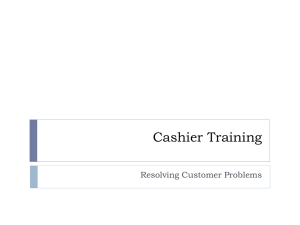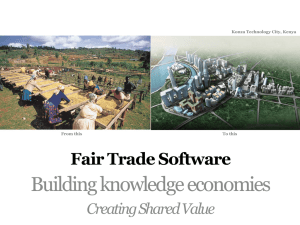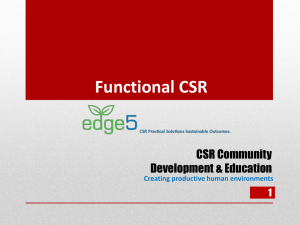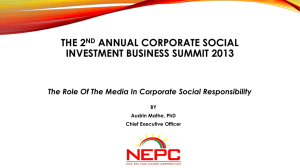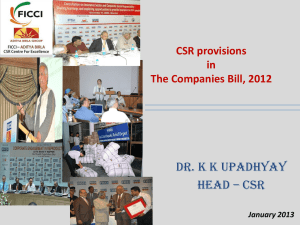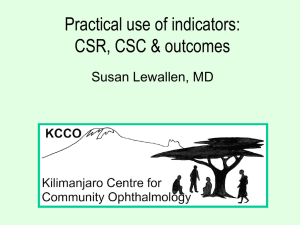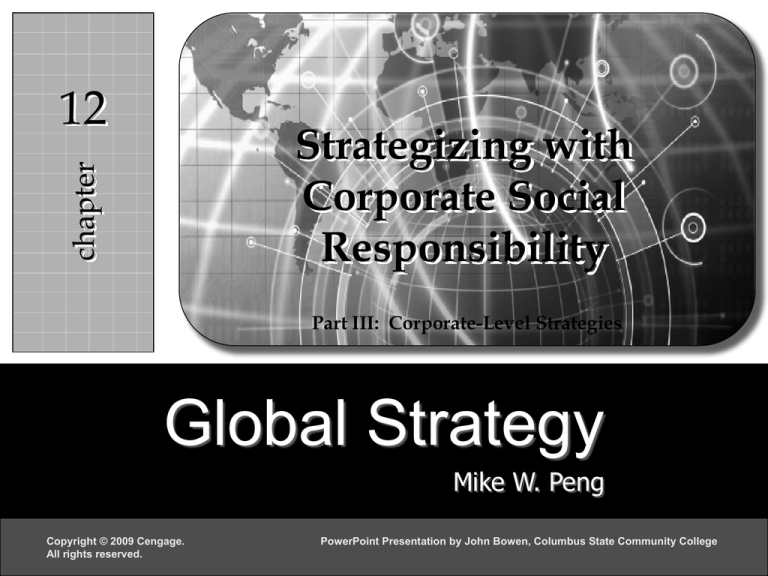
12
12
hapter
c chapter
Strategizing with
Corporate Social
Responsibility
Part III: Corporate-Level Strategies
Global Strategy
Mike W. Peng
Copyright © 2009 Cengage.
All rights reserved.
PowerPoint Presentation by John Bowen, Columbus State Community College
Outline
• A stakeholder view of the firm
• A comprehensive model of corporate social
responsibility
• Debates and extensions
• The savvy strategist
Copyright © 2009 Cengage. All rights reserved.
12–2
A Stakeholder View of the Firm
• A stakeholder is “any group or individual who can affect
or is affected by the achievement of the organization’s
objectives”
• A big picture perspective
Goal for CSR is global sustainability, defined as the ability “to
meet the needs of the present without compromising the ability
of future generations to meet their needs”
Drivers of global sustainability; rising levels of population and
inequity, and stubbornly high levels of poverty in some countries
Stakeholders have the ability to affect firms
Copyright © 2009 Cengage. All rights reserved.
12–3
A Stakeholder View of the Firm (cont’d)
• Primary and secondary stakeholder groups
Primary stakeholder groups are those on whom the
firm relies for survival and prosperity
Secondary stakeholder groups are defined as “those
who influence or affect, or are influenced or affected
by, the corporation, but they are not engaged in
transactions with the corporation and are not
essential for its survival”
Copyright © 2009 Cengage. All rights reserved.
12–4
A Stakeholder View of the Firm: A
Fundamental Debate
• The CSR debate centers on the nature of the
firm in society. Why does the firm exist?
• One side of the debate argues the “the social
responsibility of business is to increase its
profits, which leads to efficient capital and
product markets”
• Advocates of shareholder capitalism argue that
if firms attempt to attain social goals, managers
will lose their focus on profit maximization
Copyright © 2009 Cengage. All rights reserved.
12–5
A Stakeholder View of the Firm: A
Fundamental Debate (cont’d)
• Few, if any, CSR advocates argue for a revival
of socialism in the world. The goal of the CSR
movement is a more humane capitalism in which
justice and fairness can be addressed
• CSR advocates argue that all stakeholders have
an equal right to bargain for a “fair deal”
Copyright © 2009 Cengage. All rights reserved.
12–6
A Stakeholder View of the Firm
Source: Adapted from T. Donaldson & L. Preston, 1995, The stakeholder theory of the corporation:
Concepts, evidence, and implications (p. 69), Academy of Management Review, 20: 65–91. Copyright ©
1995. Reprinted by permission of Academy of Management Review via Copyright Clearance Center.
Copyright © 2009 Cengage. All rights reserved.
Figure 12.1
12–7
Managers: A Unique Group of
Stakeholders
• The free market and CSR camps agree:
Not to rock the capitalistic boat
On the central role of managers
• Managers, as a stakeholder group, are uniquely
positioned at the center of all stakeholder
relationships
Managers make decisions on behalf of the firm which
affect all other stakeholders
Therefore, it is important to understand how they
make decisions concerning CSR
Copyright © 2009 Cengage. All rights reserved.
12–8
A Comprehensive Model
of Corporate Social
Responsibility
Figure 12.2
Copyright © 2009 Cengage. All rights reserved.
12–9
Rivalry Among Competitors
• Mutual Interdependence
Reliance on old ways of doing business allows
competitors to resist higher CSR standards
• Increases in the Number of Rivals
Competition based on CSR is lower when there are a
small number of players determined to resist
As the number of rivals increases, maintaining the
collusion to resist CSR among industry competitors
becomes difficult and can collapse
Copyright © 2009 Cengage. All rights reserved.
12–10
Threat of Potential Entry
• For incumbents, investments in CSR-related
activities may allow them to ride down
experience curves and deter potential entrants
• First mover experience in pollution control
technologies can create entry barriers
Effectiveness as entry barriers for two pollution
control technologies—pollution prevention and
pollution reduction—is not equal
The technologies creating the most effective entry
barriers are proactive, pollution prevention—not
end-of-pipe, pollution reduction
Copyright © 2009 Cengage. All rights reserved.
12–11
Bargaining Power of Suppliers / Buyers
• If socially and environmentally conscious
suppliers provide unique, differentiated products
with few or no substitutes, their bargaining
power is likely to be substantial
• CSR conscious buyers can extract concessions
Individual buyers: Shell’s North Sea platform fiasco
Corporate buyers: Nike requires its suppliers to be
“sweatshop”-free
Buyers in great difficulties can extract CSR
concessions
Copyright © 2009 Cengage. All rights reserved.
12–12
Threat of Substitutes
• If substitutes are superior to existing products
and costs are reasonable, they attract more
customers
Wind power, much more environmentally friendly
than fossil-fuels and safer than nuclear power, may
have great potential
• Overall, the threat of substitutes requires firms to
vigilantly scan the larger environment, instead of
narrowly focusing on the focal industry
Copyright © 2009 Cengage. All rights reserved.
12–13
Turning Threats to Opportunities
• Not all industries are equal nor are any
industries immune in terms of their exposure to
CSR challenges
• Industries and firms may want to selectively but
proactively turn threats into opportunities
Treating CSR as a cost or nuisance may
underestimate strategic business opportunities
The most proactive managers are far-sighted to make
their firm’s CSR activities a source of differentiation as
opposed to an additional cost
Copyright © 2009 Cengage. All rights reserved.
12–14
Resource-Based Considerations
• Value: Some CSR policies may reduce the firm’s
value
• Rarity: CSR policies may not pay off if common
• Imitability: CSR that is embedded in people is
harder to imitate
• Organization: A firm needs to tie together CSR
activities
• The CSR-economic performance puzzle: Does
CSR improve economic performance?
Copyright © 2009 Cengage. All rights reserved.
12–15
The Question of Value
• Large firms, especially MNEs, can apply their
financial, technological, and human resources
toward a variety of CSR causes
Social issue participation (involvement in social
causes not directly related to managing primary
shareholders) does not qualify as value-adding
activities and may actually reduce shareholder value
Expertise, techniques, and processes associated with
the direct management of primary stakeholder groups
are likely to add value
Competing on diversity via internships, scholarships, ad
campaigns, and aggressive recruiting of minority candidates
Copyright © 2009 Cengage. All rights reserved.
12–16
The Question of Rarity
• If competitors also possess certain valuable
resources and capabilities, then the focal firm
does not gain a competitive advantage by
having them
Valuable but common resources and capabilities only
provide competitive parity
Only valuable and rare resources and capabilities can
provide focal firms some competitive advantage
Copyright © 2009 Cengage. All rights reserved.
12–17
The Question of Imitability
• Only valuable and rare resources and
capabilities that are hard-to-imitate can offer
firms sustainable competitive advantage
CSR-related resources and capabilities deeply
embedded in the idiosyncratic managerial and
employee skills, attitudes, and interpretations of firms
The socially complex way of CSR engagement is
difficult to imitate
Copyright © 2009 Cengage. All rights reserved.
12–18
The Question of Organization
• Complementary Assets
Assets that, when combined with valuable, rare, and
hard-to-imitate resources and capabilities, enable a
firm to fully utilize its CSR potential
Formal management control systems
Codified production and engineering processes
Informal relationships between managers and employees
Difficult to “fake it:” These assets should grow from
more general business strategies (e.g.,
differentiation)
Copyright © 2009 Cengage. All rights reserved.
12–19
CSR Economic Performance Puzzle
• Why is there no conclusive evidence on a direct,
positive link between CSR and economic
performance?
• Various studies produce different results
• Not every firm benefits from CSR
Copyright © 2009 Cengage. All rights reserved.
12–20
Institution-Based Considerations
• Reactive strategy: Many cost-conscious manufacturers
•
•
•
•
ignore CSR
Defensive strategy: Argue against costs
Accommodative strategy: CSR as a worthwhile endeavor
Proactive strategy: Actively participate in policy
discussions, build alliances with stakeholders and
voluntarily go beyond what the regulations require
Making strategic choices: A strategic menu of choices
among reactive, defensive, accommodative, and
proactive strategies
Copyright © 2009 Cengage. All rights reserved.
12–21
Reactive Strategy
• Characterized by a lack of support by top
management for CSR causes
• The need to accept CSR is neither internalized
through cognitive beliefs, nor becoming any
norms in practice, leaving only formal regulatory
pressures to compel firms into compliance
• CSR Movement
Emerged in response to the blatant lack of
responsiveness toward CSR
Copyright © 2009 Cengage. All rights reserved.
12–22
Defensive Strategy
• Focuses on regulatory compliance with only piecemeal
involvement by top management
• CSR issues are regarded as an added cost or nuisance
• Firms admit responsibility, but often fight it
• In the absence of informal normative and cognitive
beliefs, it seems that formal regulatory pressures are the
only feasible way to push firms ahead
Governments force polluters pay “green taxes”
The Clean Air Act of 1970
Copyright © 2009 Cengage. All rights reserved.
12–23
Accommodative Strategy
• Individuals and firms make rational choices given the
right kind of institutional incentives
• From both normative and cognitive standpoints, it may
become a legitimate social obligation to accept
responsibility and do all that is required
A negative view: Window dressing?
A positive view: Doing the right thing?
An instrumental view: Another plot to make money?
• Institution-based answer: All of the above
From window dressing to self-motivated, better corporate
citizens
Copyright © 2009 Cengage. All rights reserved.
12–24
Proactive Strategy
• Proactive participation in regional, national, and
international policy discussions
• Alliances with stakeholder groups (e.g., NGOs)
Alliances with NGOs: The key lies in identifying shortterm, manageable projects of mutual interests
• Voluntary activities beyond what is legally
required
Refuting the “pollution haven” hypothesis
Copyright © 2009 Cengage. All rights reserved.
12–25
Debates and Extensions
• Domestic versus overseas social responsibility
Potentially increases corporate profits, provides employment to
host countries and increases standards of living there
However, often domestic employees and communities pay the
price for this expansion
• Active versus inactive engagement overseas: To what
extent should an MNE use threats or its power to impose
its values in a country?
• Race to the bottom (“pollution haven”) versus race to the
top: Some companies may move to a country to escape
environmental regulations
Copyright © 2009 Cengage. All rights reserved.
12–26
The Savvy Strategist
• Managers may want to integrate CSR as part of the core
activities of the firm—instead of “faking it” and making
cosmetic changes
• Managers need to pick CSR battles carefully
• Strategists need to understand the formal and informal
rules of the game, anticipate changes, and seek to
shape such changes
• From a CSR perspective, we can revisit the four
fundamental questions
• The globally ambiguous and different CSR standards,
norms, and expectations cause many managers to
relegate CSR to the “backburner,” but they have
responsibility to safeguard and advance capitalism by
building more humane, more inclusive, and fairer firms
Copyright © 2009 Cengage. All rights reserved.
12–27


